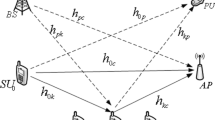Abstract
This paper investigates a cooperative spectrum sharing model where both the primary and secondary systems are two-way relaying-based systems. This model is also known as four-way relaying-based cooperative spectrum sharing. In the scenario of multiple relays, we propose a transmission scheme that enables a degradation-free primary system, exploitation of spatial diversity without using any interference constraint at the primary receivers. In this scheme, both of the primary and secondary systems employ the two-way amplify-and-forward (AF) relaying-based transmission (TW-AF-RT) within two timeslots and with the help of \(M\) relays \(R_1,\ldots ,R_M\). The system operates in three modes: simultaneous sharing (SimS) mode, primary-single-access (PSA) mode, and secondary-single-access (SSA) mode. The SimS mode is a four-way AF relaying-based transmission, and it is prioritized when at least one relay node satisfies that both systems are not in outage. In this mode, the pulse-amplitude-modulation (PAM) signal is employed to present the information messages of the sources. As a result, the best relay selection method, which is based on the max–min rule, is still applicable for the exploitation of spatial diversity in this mode. Only the primary system accesses the spectrum in the PSA mode while only the secondary system does this in the SSA mode. In both the PSA and SSA modes, complex signals are used to present the information messages of the related sources instead of PAM signals. These modes are used when the SimS mode is not available. The analysis and simulation results are conducted to validate the advantages of the proposed scheme.








Similar content being viewed by others
References
Han, Y., Pandharipande, A., & Ting, S.H. (2008). Cooperative spectrum sharing via controlled amplify-and-forward relaying. In Personal, Indoor and Mobile Radio Communications, 2008. PIMRC 2008. IEEE 19th International Symposium on, pp. 1–5.
Yang, H., Pandharipande, A., & See, T. (2009). Cooperative decode-and-forward relaying for secondary spectrum access. IEEE Transactions on Wireless Communications, 8, 4945–4950.
Yang, H., See Ho, T., & Pandharipande, A. (2010). Cooperative spectrum sharing with distributed secondary user selection. In 2010 IEEE International Conference on Communications (ICC), pp. 1–5.
Yang, H., & See Ho, T. (2010). Cooperative spectrum sharing protocol with secondary user selection. IEEE Transactions on Wireless Communications, 9, 2914–2923.
Yang, H., See Ho, T., & Pandharipande, A. (2012). Cooperative spectrum sharing protocol with selective relaying system. IEEE Transactions on Communications, 60, 62–67.
Li, Q., Ting, S. H., Pandharipande, A., & Motani, M. (2012). Cooperate-and-access spectrum sharing with ARQ-based primary systems. IEEE Transactions on Communications, 60, 2861–2871.
Yang, H., See Ho, T., Motani, M., & Pandharipande, A. (2011). On throughput and delay scaling with cooperative spectrum sharing. In 2011 IEEE International Symposium on Information Theory Proceedings (ISIT), pp. 821–825.
Kim, K. J., Duong, T. Q., & Tran, N. (2012). Performance analysis of cognitive spectrum-sharing single-carrier systems with relay selection. In IEEE Transactions on Signal Processing, 60(12), 6435–6449.
Wei Dang, L., Yi, G., See Ho, T., Xuan Li, W., & Nai Tong, Z. (2012). Cooperative OFDM relaying for opportunistic spectrum sharing: Protocol design and resource allocation. IEEE Transactions on Wireless Communications, 11, 2126–2135.
Duong, T., da Costa, D., Tsiftsis, T., Zhong, C., & Nallanathan, A. (2012). Outage and diversity of cognitive relaying systems under spectrum sharing environments in Nakagami-m fading. In IEEE on Communications Letters, 16(12), 2075–2078.
Xia, M., & Aissa, S. (2012). Cooperative AF relaying in spectrum-sharing systems: Outage probability analysis under co-channel interferences and relay selection. In IEEE Transactions on Communications, 60(11), 3252–3262.
MinChul, J., & Il-Min, K. (2010). Relay selection with ANC and TDBC protocols in bidirectional relay networks. IEEE Transactions on Communications, 58, 3500–3511.
Benevides da Costa, D., Haiyang, D., Yacoub, M.D., & Jianhua, G. (2012). Outage analysis of two-way relaying in interference-limited AF cooperative networks over Nakagami-m fading. In Wireless Communications and Networking Conference (WCNC), 2012 IEEE, pp. 561–564.
Qiang, L., See Ho, T., Pandharipande, A., & Yang, H. (2009). Adaptive two-way relaying and outage analysis. IEEE Transactions on Wireless Communications, 8, 3288–3299.
Qiang, L., See Ho, T., Pandharipande, A., & Yang, H. (2011). Cognitive spectrum sharing with two-way relaying systems. IEEE Transactions on Vehicular Technology, 60, 1233–1240.
Li, Y., Peng, M., & Wang, W. (2012). Spectrum sharing in cognitive two-way relay networks. In Globecom 2012.
Duy, T., & Kong, H.-Y. (2013). Performance analysis of two-way hybrid decode-and-amplify relaying scheme with relay selection for secondary spectrum access. Wireless Personal Commununications, 69, 857–878.
Yang, L., Alouini, M. S., & Qaraqe, K. (2012). On the performance of spectrum sharing systems with two-way relaying and multiuser diversity. IEEE on Communications Letters, 16, 1240–1243.
Zhongyuan, Zhao, Zhiguo, Ding, Peng, M., Wenbo, Wang, & Leung, K. K. (2011). A special case of multi-way relay channel: When beamforming is not applicable. IEEE Transactions on Wireless Communications, 10(7), 2046.
Liu, H., Popovski, P., de Carvalho, E., Zhao, Y., Sun, F., & Thai, C. D. T. (2012). Transmission schemes for four-way relaying in wirelss cellular systems. arXiv:1209.5829v1. http://arxiv.org/abs/1209.5829.
Acknowledgments
This work was supported by 2014 Research Funds of Hyundai Heavy Industries for University of Ulsan.
Author information
Authors and Affiliations
Corresponding author
Rights and permissions
About this article
Cite this article
Tran, T.T., Kong, H.Y. Exploitation of Diversity in Cooperative Spectrum Sharing with the Four-way Relaying AF Transmission. Wireless Pers Commun 77, 2959–2980 (2014). https://doi.org/10.1007/s11277-014-1679-1
Published:
Issue Date:
DOI: https://doi.org/10.1007/s11277-014-1679-1




